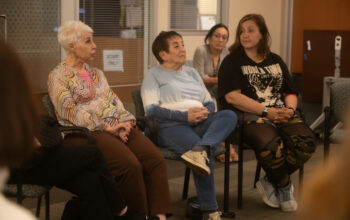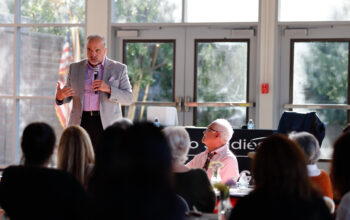Using film to affect society was one of the main points discussed by members of a panel in The Great Hall on Wednesday.
After a powerful screening of The Welcome, a healing journey for war veterans and their families on Wednesday, March 21. different members of the community were on hand to take questions.
Jon Fitzgerald, CEO of CineCause, Jerry Melnyk, from the Sepulveda Vet Center, and Kathy Oborn, the Chair of Political Science, Economics, Criminal Justice, Law and Chicano Studies were on the panel.
Fitzgerald’s company CineCause took the film “The Welcome” to different festivals in order for it to gain exposure and has moderated Q&A’s before.
His initial reaction to the film was common among students that attended the screening.
“This is one of the most powerful movies I’ve ever seen, it’s one of those movies that kind of sneaks up on you,” Fitzgerald said.
He also warns the audience, “you don’t really know what you are getting into when the lights go off.”
He feels that because the usage of film is so powerful, it will show audiences who would normally not be exposed to this type of situation more of an understanding.
“(When) film makers (are) frustrated with the situation going on around the world, they wanted to do something about it, and film is our most powerful form of mass communication,” Fitzgerald said.
During the panel he used such examples as “Super Size Me”, “An Inconvenient Truth”, and “March of the Penguins” to explain the way that these types of documentaries affect people.
The panel also discussed the dangers of media.
Students made different points about how coverage about the war specifically, is mostly negative. A recent example is of Staff Sgt. Robert Bales, who is being accused of killing 17 Afghan villagers.
It was also brought up about how Americans are not shown the effects that innocent civilians are dealing with.
Melnyk and Oborn brought up how difficult it is for returning soldiers to adapt to civilian life.
Melnyk is a veteran himself and understands what it is like to come home.
“One of the first question (civilians) ask is: How many people did you kill?” Melnyk said.
He later explained that in reality if the solider does not kill then they will be killed.
Oborn reveled that her own son is a veteran and because of specific training that he received while serving in the military he has developed certain needs that others would deem peculiar.
“When my son and I go out to eat we have to sit in the back of the restaurant,” Oborn said.
However, not everyone found the panel useful.
Antonio Martinez, is a phycology major, did one tour to Afghanistan as combat deployment in O311 Infantry part of the 1st Battalion 5th Marine and was part of Operation Khanjar.
Martinez’s frustration was shielded by a friendly smile.
“It’s a little bit of frustration from these college students talking about how they try to understand what we’re going through but they just don’t get it,” Martinez said. “The way I see it, if you didn’t experience it, you have nothing to say and if you do say something it’s going to offend us.”
He shared one vital piece of information.
“I don’t know, they way I see it veterans keep to themselves. They don’t want to be helped and when they do, they go to someone personal,” Martinez said.
To learn more about The Welcome visit: www.thewelcomethemovie.com/ and for a review of the film visit: www.theroundupnews.com/2012/03/26/students-find-healing-through-film/


